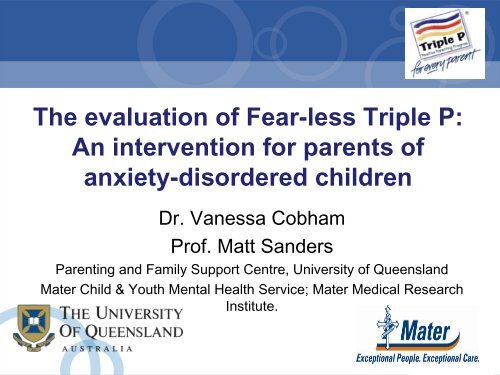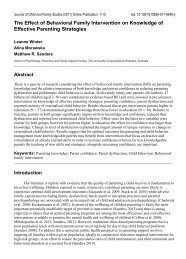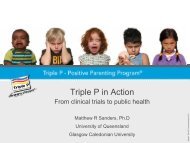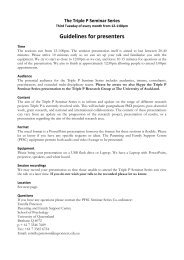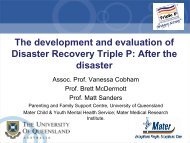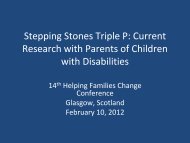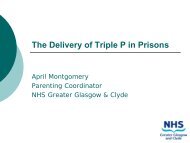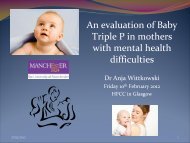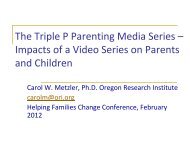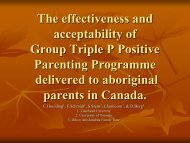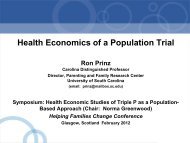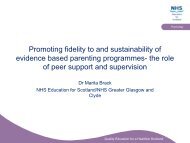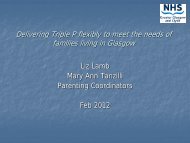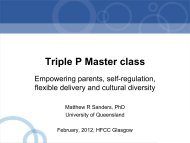The evaluation of Fear-less Triple P - Parenting and Family Support ...
The evaluation of Fear-less Triple P - Parenting and Family Support ...
The evaluation of Fear-less Triple P - Parenting and Family Support ...
Create successful ePaper yourself
Turn your PDF publications into a flip-book with our unique Google optimized e-Paper software.
<strong>The</strong> <strong>evaluation</strong> <strong>of</strong> <strong>Fear</strong>-<strong>less</strong> <strong>Triple</strong> P:<br />
An intervention for parents <strong>of</strong><br />
anxiety-disordered children<br />
Dr. Vanessa Cobham<br />
Pr<strong>of</strong>. Matt S<strong>and</strong>ers<br />
<strong>Parenting</strong> <strong>and</strong> <strong>Family</strong> <strong>Support</strong> Centre, University <strong>of</strong> Queensl<strong>and</strong><br />
Mater Child & Youth Mental Health Service; Mater Medical Research<br />
Institute.
<strong>The</strong> significance <strong>of</strong> anxiety in<br />
children <strong>and</strong> adolescents<br />
• Most common form <strong>of</strong> psychopathology<br />
reported by children<br />
• Psychosocial consequences<br />
– School & social performance<br />
– Physical health problems<br />
• Poor prognosis<br />
• <strong>The</strong> families <strong>of</strong> anxiety-disordered children<br />
• <strong>The</strong> poor reach <strong>of</strong> existing treatments
Treatment outcome research:<br />
What do we know?<br />
• Child-focused CBT = gold st<strong>and</strong>ard<br />
– is an efficacious & useful treatment for anxiety in<br />
children (Cartwright-Hatton et al., 2004; Chorpita &<br />
Daleiden, 2007).<br />
– Across studies, the average remission rate at posttreatment<br />
is 56.5%.<br />
– That’s not bad. BUT, <strong>of</strong> course, children live in<br />
families.<br />
• Child + parent interventions – unclear that<br />
involving parents enhances benefits<br />
• Parent-focused interventions
Introducing “<strong>Fear</strong>-<strong>less</strong>” <strong>Triple</strong> P<br />
• A 6-session parenting intervention (Cobham &<br />
S<strong>and</strong>ers, 2009) designed to:<br />
– Educate parents about anxiety in children; their own<br />
potential role in maintaining children’s anxiety;<br />
avoidance & exposure; mental flexibility; & helpful<br />
vs. <strong>less</strong> helpful parental responses to children’s<br />
anxiety;<br />
– Empower parents to take on their role as the most<br />
powerful agent for change for their children; <strong>and</strong><br />
– Produce radiating effects within the families <strong>of</strong><br />
anxiety-disordered children.
“<strong>Fear</strong>-<strong>less</strong>” <strong>Triple</strong> P pilot<br />
• N = 60 families with a child aged 7-14 meeting<br />
criteria for a clinically significant anxiety diagnosis<br />
on the ADIS-IV-C/P;<br />
• R<strong>and</strong>om assignment to WL or “<strong>Fear</strong>-<strong>less</strong>” <strong>Triple</strong> P<br />
• Measures<br />
– Child: SCAS; EMBU-C<br />
– Parents: SCAS-P; EMBU-P; <strong>Parenting</strong> Scale; Parent<br />
Problem Checklist; Relationship Quality Index; DASS-<br />
21; & <strong>Parenting</strong> Tasks Checklist<br />
• Follow-up points: post, 3-mth, 6-mth & 12-mth.
“<strong>Fear</strong>-<strong>less</strong>” Pilot: Diagnostic data<br />
(Cobham, S<strong>and</strong>ers & Valvoi, in preparation)
“<strong>Fear</strong>-<strong>less</strong>” Pilot: Child self-<br />
report (Cobham, S<strong>and</strong>ers & Valvoi, in preparation)
Conclusions <strong>and</strong> Future Directions<br />
Conclusions <strong>and</strong> Implications<br />
– Strong, preliminary support for the efficacy <strong>of</strong> this<br />
brief, 6-session parenting intervention in the<br />
treatment <strong>of</strong> anxiety disordered children <strong>and</strong><br />
adolescents<br />
– Exciting potential for extending reach (including<br />
previously ‘difficult to work with’ populations)<br />
Future Directions<br />
1.Replication in other sites & an RCT<br />
2.How light could we go?<br />
3.Mediators <strong>and</strong> moderators
Thank you.<br />
vanessa@psy.uq.edu.au


